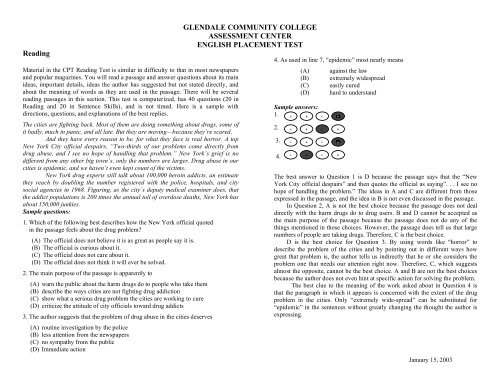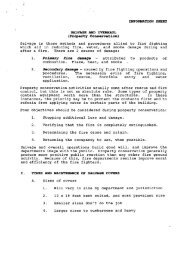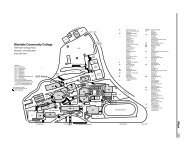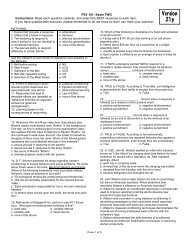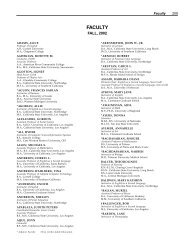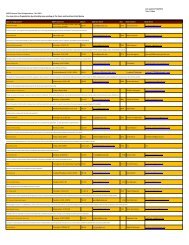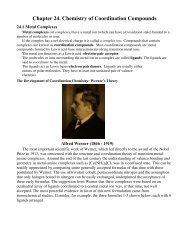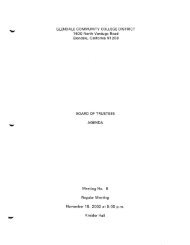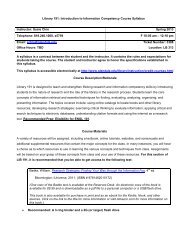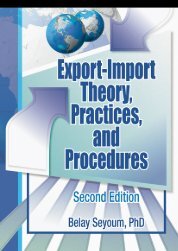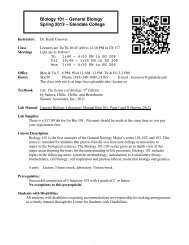Sample English Placement Test - Glendale Community College
Sample English Placement Test - Glendale Community College
Sample English Placement Test - Glendale Community College
Create successful ePaper yourself
Turn your PDF publications into a flip-book with our unique Google optimized e-Paper software.
Reading<br />
Material in the CPT Reading <strong>Test</strong> is similar in difficulty to that in most newspapers<br />
and popular magazines. You will read a passage and answer questions about its main<br />
ideas, important details, ideas the author has suggested but not stated directly, and<br />
about the meaning of words as they are used in the passage. There will be several<br />
reading passages in this section. This test is computerized, has 40 questions (20 in<br />
Reading and 20 in Sentence Skills), and is not timed. Here is a sample with<br />
directions, questions, and explanations of the best replies.<br />
The cities are fighting back. Most of them are doing something about drugs, some of<br />
it badly, much in panic, and all late. But they are moving—because they’re scared.<br />
And they have every reason to be, for what they face is real horror. A top<br />
New York City official despairs, “Two-thirds of our problems come directly from<br />
drug abuse, and I see no hope of handling that problem.” New York’s grief is no<br />
different from any other big town’s, only the numbers are larger. Drug abuse in our<br />
cities is epidemic, and we haven’t even kept count of the victims.<br />
New York drug experts still talk about 100,000 heroin addicts, an estimate<br />
they reach by doubling the number registered with the police, hospitals, and city<br />
social agencies in 1968. Figuring, as the city’s deputy medical examiner does, that<br />
the addict populations is 200 times the annual toll of overdose deaths, New York has<br />
about 150,000 junkies.<br />
<strong>Sample</strong> questions:<br />
1. Which of the following best describes how the New York official quoted<br />
in the passage feels about the drug problem?<br />
(A) The official does not believe it is as great as people say it is.<br />
(B) The official is curious about it.<br />
(C) The official does not care about it.<br />
(D) The official does not think it will ever be solved.<br />
2. The main purpose of the passage is apparently to<br />
(A) warn the public about the harm drugs do to people who take them<br />
(B) describe the ways cities are not fighting drug addiction<br />
(C) show what a serious drug problem the cities are working to cure<br />
(D) criticize the attitude of city officials toward drug addicts<br />
3. The author suggests that the problem of drug abuse in the cities deserves<br />
(A) routine investigation by the police<br />
(B) less attention from the newspapers<br />
(C) no sympathy from the public<br />
(D) Immediate action<br />
GLENDALE COMMUNITY COLLEGE<br />
ASSESSMENT CENTER<br />
ENGLISH PLACEMENT TEST<br />
4. As used in line 7, “epidemic” most nearly means<br />
(A)<br />
(B)<br />
(C)<br />
(D)<br />
<strong>Sample</strong> answers:<br />
1.<br />
2.<br />
3.<br />
4.<br />
A B C<br />
D<br />
A B C<br />
D<br />
A B C<br />
D<br />
A B C<br />
D<br />
against the law<br />
extremely widespread<br />
easily cured<br />
hard to understand<br />
The best answer to Question 1 is D because the passage says that the “New<br />
York City official despairs” and then quotes the official as saying”. . . I see no<br />
hope of handling the problem.” The ideas in A and C are different from those<br />
expressed in the passage, and the idea in B is not even discussed in the passage.<br />
In Question 2, A is not the best choice because the passage does not deal<br />
directly with the harm drugs do to drug users. B and D cannot be accepted as<br />
the main purpose of the passage because the passage does not do any of the<br />
things mentioned in those choices. However, the passage does tell us that large<br />
numbers of people are taking drugs. Therefore, C is the best choice.<br />
D is the best choice for Question 3. By using words like “horror” to<br />
describe the problem of the cities and by pointing out in different ways how<br />
great that problem is, the author tells us indirectly that he or she considers the<br />
problem one that needs our attention right now. Therefore, C, which suggests<br />
almost the opposite, cannot be the best choice. A and B are not the best choices<br />
because the author does not even hint at specific action for solving the problem.<br />
The best clue to the meaning of the work asked about in Question 4 is<br />
that the paragraph in which it appears is concerned with the extent of the drug<br />
problem in the cities. Only “extremely wide-spread” can be substituted for<br />
“epidemic” in the sentences without greatly changing the thought the author is<br />
expressing.<br />
January 15, 2003
Sentence Skills<br />
In this test, you will show your skill in standard written <strong>English</strong>, the kind you<br />
will probably need in your courses and on the job.<br />
Directions: Select the best version of the underlined part of the sentence.<br />
Choice (A) is the same as the original sentence. If you think the original<br />
sentence is the best, choose answer (A).<br />
<strong>Sample</strong> questions:<br />
1. The nervous student walked into the school to see his teacher with<br />
trembling knees.<br />
A. The nervous student walked into the school to see his teacher with<br />
trembling knees.<br />
B. With trembling knees the nervous student walked into the school to<br />
see his teacher.<br />
C. The nervous student walked into the school with trembling knees to<br />
see his teacher.<br />
D. Nervous, the student walked into the school to see his teacher with<br />
trembling knees.<br />
2. Most people approved of the candidate nevertheless most of them<br />
did not bother to vote.<br />
A. candidate nevertheless<br />
B. candidate nevertheless,<br />
C. candidate, nevertheless,<br />
D. candidate; nevertheless,<br />
GLENDALE COMMUNITY COLLEGE<br />
ASSESSMENT CENTER<br />
ENGLISH PLACEMENT TEST<br />
In Question 2, circle D is marked because it is the only correct choice for<br />
connecting two independent clauses.<br />
Directions: Rewrite these sentences in your head, then choose the best answer.<br />
Rewrite, beginning with:<br />
1. Jennifer has an exam today,<br />
The next words will be:<br />
A. and she went to the movies last night.<br />
B. but she went to the movies last night.<br />
C. therefore she went to the movies last night.<br />
D. until she went to the movies last night.<br />
2. The lost wallet promptly returned to me by a customer at the grocery store.<br />
Rewrite, beginning with:<br />
A customer<br />
Your new sentence will include:<br />
A. has been returned promptly<br />
B. will promptly return<br />
C. returns promptly<br />
D. promptly returned<br />
<strong>Sample</strong> Answers:<br />
1.<br />
A B C<br />
D<br />
<strong>Sample</strong> Answers:<br />
1.<br />
2.<br />
A<br />
B<br />
A B C D<br />
D<br />
In Question 1, circle B is marked because the description, “with trembling<br />
knees,” must be placed next to the appropriate person.<br />
2.<br />
A B C D<br />
In Question 1, circle B is marked because only “but” shows that the two<br />
actions are in opposition.<br />
In Question 2, circle D is marked because “returned” is the correct verb<br />
tense for the sentence.<br />
January 15, 2003


